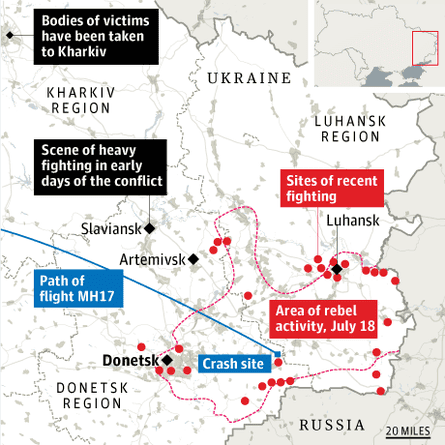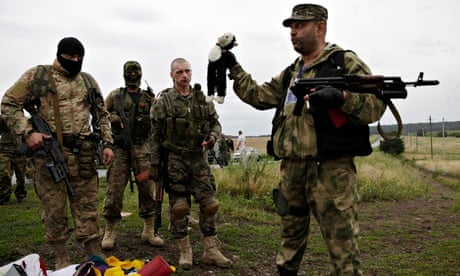Pro-Russia separatist groups in eastern Ukraine are hastily covering up all links to the Buk missile battery suspected to have been used to shoot down the Malaysia Airlines passenger plane, according to western-based defence and intelligence specialists.
As the UN security council called for a "full, thorough independent international investigation" into the downing of the plane, concern that a cover-up was under way was fuelled by a standoff at part of the crash site between observers from the Organisation for Security and Co-operation in Europe (OSCE) and rebel gunmen, which ended with a warning shot being fired.
Postings on rebel websites immediately after the crash boasted of having shot down what they claimed was an Antonov Ukrainian military transport plane, but these have since been deleted.
In Washington, President Obama called for a full, impartial investigation and said the tragedy should cause people to "snap their heads together" and stop playing games in Ukraine. Putting pressure on Moscow over Ukraine, Obama said: "The violence that's taking place there is facilitated in large part because of Russian support."
Australian prime minister Tony Abbott, whose country lost 28 lives in the disaster, dispatched foreign minister Julie Bishop to New York to lobby for a binding UN resolution for a "full and impartial" investigation.
Britain and Australia have already sent officials to Ukraine to assist with the investigation and Malaysia said on Saturday that its transport minister will fly to the country to try to ensure an investigating team gets safe access to the site of the downed plane.
The US ambassador to the UN, Samantha Power, blamed a surface-to-air missile fired by rebels in eastern Ukraine and hinted that they might have had Russian technical help. The rebels are suspected of having used a Russian-built, vehicle-mounted Buk missile system to bring down MH17, killing all 298 passengers and crew. Power called for the crash site to be preserved. "All evidence must be undisturbed," she said. "Russia needs to help make this happen."

But hopes are not high. The OSCE was trying to gain access to one part of the large crash site but the commander of a rebel unit, known as Commander Glum, blocked them. After the warning shot, the OSCE convoy departed.
There is also confusion over the black boxes and other devices apparently salvaged from the plane. A rebel military commander initially said he was considering what to do with them, while another rebel leader, Aleksandr Borodai, contradicting his colleague, said the rebels had no black boxes or any other devices.
The Ukrainian interior ministry added to fears of a cover-up when it released video purportedly taken by police showing a truck carrying a Buk missile launcher with one of its four missiles apparently missing, rolling towards the Russian border at dawn . The video could not be independently verified.
Other material on rebel social media sites was being deleted, including pictures showing the alleged capture of Buk missile vehicles by rebels from a Ukrainian air base last month.
Rebels said the boast on the social media site on Thursday that a plane had been shot down was not put up by them but by a sympathiser who mistakenly assumed it was a Ukrainian military plane that had been shot down. But in a separate posting a rebel leader also claimed that a plane had been brought down. "We warned you – do not fly in our sky," he said. That too was removed.
A Nato intelligence specialist quoted by the military analysts Janes said the recordings "show that the Russian 'helpers' realise that they now have an international incident on their hands – and they probably also gave the order for separatists to erase all evidence – including those internet postings. It will be interesting to see if we ever find this Buk battery again or if someone now tries to dump it into a river."
Video footage allegedly taken on Thursday appeared to support the idea that pro-Russia separatists had been to blame. It showed a Buk battery seemingly being moved in the rebel-held area between Snizhne and Torez close to the crash site. A still picture allegedly shows a missile in vertical launch mode beside a supermarket in Torez. However, the location has still to be established.
Ukrainian intelligence has published a tape said to be a recording between rebels and Russian intelligence in which they realise there has been a catastrophic blunder. One recording is said to be between a rebel commander, Igor Bezler, and a Russian intelligence officer in which he says: "We have just shot down a plane." A second recording from an unidentified source puts the blame on Cossack militiamen.
Defence analysts with Russian expertise shared Power's scepticism that Russia-backed rebel groups would have had the expertise to fire the missile and suggested it was more likely to have been Russian ground troops who specialise in air defence, seconded to help the rebels.
At the Pentagon, officials said a motive for the operation had yet to be determined, as had the chain of command. One said it would be "surprising to us" if pro-Russia separatists were able to operate the Buk missile battery without Russian technical support. The Ukrainian military confirmed it has Buk batteries but said it had none in the area the missile was fired.
Nato had Awacs surveillance and command-and-control planes flying in the Baltics around the time of the crash, but Pentagon officials did not think the aircraft picked up indications of the disaster.
Bob Latiff, a former US weapons developer for the air force and the CIA and now a professor at Notre Dame University, said he leaned towards a belief that it was a case of mistaken identity on the part of those who pressed the button.
"A radar return from an airplane like this would look very similar to that from a cargo plane, as was initially claimed by the separatists. If radar was all they were using, that is a shame," he said. "All airliners emit identification signals which identify the aircraft and provide other information like altitude and speed. They also operate on known communications frequencies. It doesn't sound like the separatists were using any of this.
"My guess is the system's radar saw a return from a big 'cargo' plane flying at 30,000 ft or so and either automatically fired, or some aggressive, itchy operator fired, not wanting to miss an opportunity."
Latiff said that if they had only one radar, as Ukrainian officials suggest, it would have been pointed at the target. A second, rotating one would normally have been part of a battery to pick up other planes in the immediate vicinity, but he said even that would not have established whether it was a commercial plane and there would normally have been communications equipment to pick up signals showing the plane was non-military.
Igor Sutyagin, a Russian military specialist at the London-based Royal United Services Institute, said he regarded the tape recordings as genuine, as well as postings on social media pointing the finger at pro-Russia separatists or Russia itself.
But getting evidence would be very difficult. He said: "A decision has been made on the Russian side to hide their tracks. It will be hard to find the battery." Satellites might have been able to catch something, but the trail from the missile would have been very short, Sutyagin said.

Comments (…)
Sign in or create your Guardian account to join the discussion